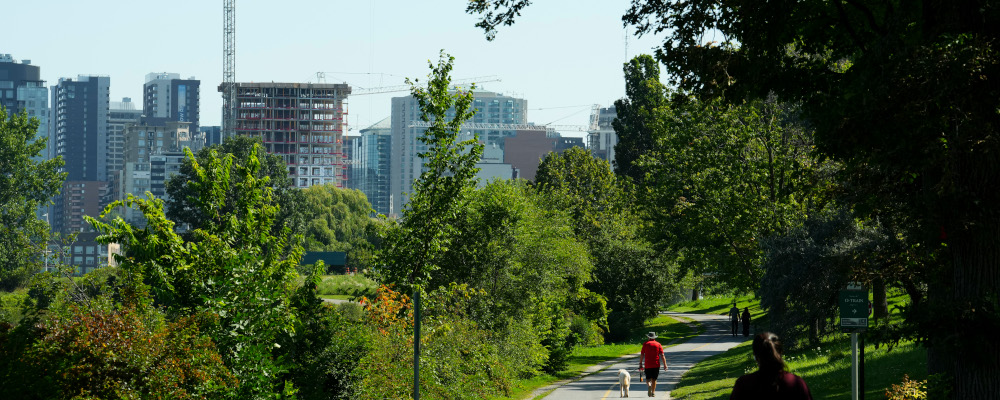I spend a lot of time in a rural part of Grey County, Ontario. The air is fresh, there are more trees than people, and there are waterfalls within walking distance of my country home.
It’s where I go with my family to feel connected to nature and to get away from the dirty, loud, and polluted city.
I have no doubt that if I asked 1,000 Canadians for a mental image of some of the most environmentally sustainable places in Canada, most would think of a place like the one I described above. These places are the epitome of green living. Or so you’d think.
The reality is actually quite the opposite.
In fact, the data would unambiguously show that the environmental impact of an average Canadian is significantly lower if they live in downtown Toronto rather than on an isolated piece of land near a typical small Canadian community, or even in that community.
The reasons for this are pretty simple:
- More efficient land use. This means more people using less land that could otherwise be agricultural or undeveloped land supporting vegetation and wildlife.
- More efficient infrastructure. This means things like sewage or water infrastructure can be shared by a high density of people rather than each home requiring a septic system and a well.
- Less driving. The higher the density, the greater the proximity to transit or walkable neighbourhoods. This ultimately means fewer and smaller cars on average.
- Less energy transmission waste. The farther energy has to travel through transmission lines, the more is wasted. This means that rural Canadians require more energy production per capita than urban Canadians
Considering all this, you’d think that Canada’s environmental policies (at all levels of government) would all point to supporting and promoting increased density in cities. And our most ardent environmentalists must be the most vocal advocates for YIMBY city development.
Not quite.
The reality in many realms of public policy is unfortunately that well-intentioned and headline-worthy policies always trump effective ones that might go unseen by the voting public.
That’s why it’s easier for a City like Toronto to introduce green building standards and net zero GHG emissions targets for 2040, rather than tackle environmental outcomes by simply building more homes faster.
Ironically, the approach taken on these environmental policies by most of our big cities has the opposite effect on the environment when you look through a provincial or national lens. All of these policies add up to more costs, delays, bureaucracy, and restrictions on building new homes. So instead of adding incremental population growth to Toronto’s core neighbourhoods, people buy homes in Milton, Shelbourne, Brantford, and Aurora—furthering the suburban sprawl that is a leading contributor to negative environmental outcomes both provincially and nationally.
The recent controversy over the Greenbelt in Ontario is an unfortunate outcome of this type of poor planning at the municipal and provincial levels. Not to say that Doug Ford isn’t ultimately responsible for decisions related to the Greenbelt, but it’s worth noting that the pressure to build outward from Toronto would be significantly reduced if City Hall took the lead in prioritising housing, without needing to be threatened by other levels of government.
Ironically, the same groups opposing the development of Highway 413 north of Toronto and the development of the Greenbelt for more housing are also strong opponents to any form of development in old Toronto neighbourhoods; the same neighbourhoods that have experienced reduced density for the past three decades as adult children move out of their parents’ homes, leaving two aging people living in a detached four bedroom house.
Now those adult children are in the market looking for homes. And I’m increasingly meeting them in places as far removed from Toronto as Grey County—my oasis outside the city. At the same age—35 years ago—their parents were buying their childhood homes on their quiet Toronto residential street.
With all this in mind, it’s probably not surprising to know that I consider myself a strong YIMBY—probably to an extreme. I get giddy when I see cranes in the sky or construction crews converting a house into a low-rise apartment. But I’d also strongly categorize myself as a NIMBY when I’m in rural Canada; in places like Grey County, Ontario, or visiting my in-laws in the Kootenay Valley, British Columbia.

These might sound like contradictory positions, but they’re not. Anyone who values the untouched beauty of Canadian nature and the quaint character of small towns should be among the most passionate big-city YIMBYs—not to mention those of us who care deeply about a clean environment.
If we’re going to add one million people to our country every year, let’s build them homes in our core cities. This is the right thing to do for the environment and for this new generation of home buyers and newcomers. People want to live near opportunity, and younger Canadians starting a family will quite often want to live near where they grew up.
Ultimately, if we can increase our urban density we’ll have created a new generation of Canadians who live and work in our economic centres, who have access to peaceful getaways in rural Canada, and who can share in our collective love of nature.
I’m not sure why anyone would consider this controversial.




